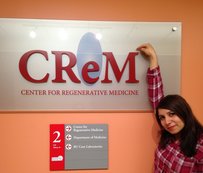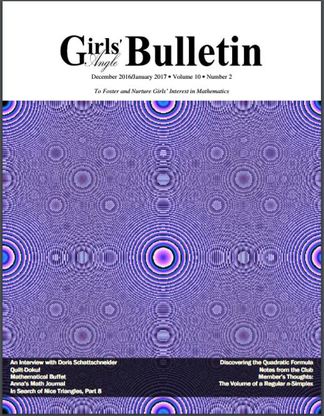|
1/17/2017 0 Comments Girls' Angle
By Sadaf Atarod
Disclaimer: views expressed herein are those of Dr. Ken Fan and do not necessarily reflect the views of the author, the editorial staff, or The Scientista Foundation. Alternative methods of education have always appealed to me. Educational approaches such as the Steiner/Waldorf model are designed to nurture children’s creativity, promoting development both in terms of intellect and art. Likewise, from personal experience and observation, academic focused clubs or groups during the school years can boost students’ confidence, as well as help them to realize their interests, and potentials. Thus, I felt very fortunate to meet with Dr. Ken Fan, the President and Founder of Girl’s Angle, at one of his Math Club for Girls events, which is hosted once per week at MIT’s Broad Institute. Interviewing Dr. Fan provided insight into how people like him play instrumental roles in empowering women by first acknowledging the existence of unconscious biases (even those held by our educators) and subsequently working to override them. To learn more about how Girl’s Angle was founded, its goals, and achievements, please read the interview with Dr. Fan. Sadaf Atarod: Ken, it is interesting how you moved from a career in academia to what they call a job in the ‘real world’. How did you transition? Ken Fan: I left academia to pursue a career as an oil painter. Painting didn't pay the bills (he laughs) so I began freelancing in math educational publishing. SA: So what was your experience in math educational publishing? KF: As a content editor in math educational publishing, I was able to see first-hand how bad math education has become in the US. Math was being improperly explained, and not merely at a factual level, but also at a conceptual level. Incredibly, despite providing clear counter examples, things would not always be changed. It got me thinking about other ways to deliver quality math education. SA: That brings me to the next question, then why focuses on Girls’ education in math? KF: A friend of mine, Beth O’Sullivan, was a co-founder of Science Club for Girls and while I was freelancing, I volunteered at that club. It was then that I was awakened to gender issues in math education. I began to realize that I had unconscious biases in my expectations in how the girls would guide the project and in the way they would respond to my questions. However, I would silently ask myself whether what the girls were doing was just different or actually mathematically inferior, and I realized that it was just different. In the end, they created something that I’d never have done myself, but it was wonderful. They built a modular origami geodesic disco ball that hung at Boston Children’s Museum for half a year. When I decided to start a math educational program, I looked around and didn’t see any comprehensive math program just for girls, run by mathematicians, where girls could keep coming back for more. So I decided to start such a program. SA: It is intriguing for me how you have been so very observant of the differences in our learning style compared to the boys. Can you elaborate more on these variations? KF: I think this is a difficult subject to discuss because there are always exceptions. But, crudely speaking, I think boys tend to be highly motivated by competition. When I work with boys, it usually isn’t very long before they’ve turned what we’re doing into a competition. It could even be something as simple as making everything about who can do it first. On the other hand, when I work with girls, we can go for very long stretches even without anyone mentioning competition. For this reason, at Girls’ Angle, we developed a new math event concept which we call the “Math Collaboration.” The name is deliberately chosen to contrast with “Math Competition.” Math Collaborations are fun, fully collaborative, mathematically intense events where participants must work together as a team to overcome a big mathematical challenge. We’ve run nearly 100 such events and it does seem to me that they work best as all-girl events, although all-boy and coed versions have been well-received. Because of the format of the Math Collaboration, it’s easier to create a richer variety of math problems and go into more depth than what one typically finds on a math competition. I think there are many other differences, on average, between boys and girls, but it would probably require a book to discuss them properly! SA: Has the insight about these gender differences been integrated in the Girls’ Angle approach to teaching math? KF: Definitely, although it doesn’t dictate what we do! We custom tailor our math education to each individual, and there is a lot of variation among individuals. There certainly are girls who enjoy competition, and for them, we will include some competitive activities. Teaching is an art that has many facets, and, without going into what the facets are, I’ll just say that because we focus on girls’ math education, the default weighting attached to the different facets is different from what you’d find at a typical, say, coed math circle or math camp. However, this absolutely does not mean that the math being taught at Girls’ Angle is watered down. It is not! SA: So what else has been done through Girls’ Angle? KF: Girls’ Angle is concerned with delivering quality math education. And while we do custom tailor the math education to the individual, we do operate from a core educational philosophy, which is that we’re really about - empowering girls to become independent, strong thinkers and problem solvers. We use mathematics as a kind of ideal vehicle for that purpose. People are the creators of mathematics and we want to embolden girls to be such creators by encouraging them to find something interesting, wonder about it, formulate questions, and try to solve their own questions. Of course, this approach is completely ineffective for certain people, so there is also a more “delivered” approach for some of our members at any given time. I tell our mentors to aim for getting members to do math not through assignment, but through inspiration. I love it when a member comes to a meet eager to show us what math she did on her own volition between meets! Also, to be comprehensive, we employ a variety of different techniques and media to deliver math education because different techniques and media have different strengths and weaknesses. For this reason, we produce math educational videos and publish a bimonthly math magazine, the Girls’ Angle Bulletin, which anyone can subscribe to. Our magazine contains articles pertaining to math and written by professional mathematicians and scientists, Girls’ Angle staff, and, occasionally, our members. There’s also an interview with a woman in mathematics in nearly every issue. Quite a bit of its contents are influenced by the math that is concurrently happening at the club. SA: Is Girls’ Angle for profit? How are the clubs run? KF: Girls' Angle is a nonprofit founded in 2007 and is registered as a charity. We rely on grants and donations. In fact, we deliberately keep our membership fees low and not a significant source of income in order to avoid conflict of interest. For example, there will be girls for whom Girls’ Angle is not a good fit, and we always want to be able to give these girls the honest advice that they would be better off elsewhere without the pressure of viewing the girls’ membership as an important source of revenue. We also want to be able to give parents our honest opinion of what would be in the best interest of their daughter in terms of their daughter’s mathematical growth even if we think there is a possibility that the parents will not particularly like what we have to say. I think it is important to be able to speak candidly with parents and never feel the urge to alter the message for fear of losing membership revenues. Thanks to their generosity and philanthropy, our physical meet location is at the Broad Institute in Kendall Square. The club meets once per week for 24 meets during the academic year and every meet lasts two hours. Occasionally, we do run summer classes. At this time, we welcome girls roughly in grades 5 through 12. All girls are welcome. We do not have an admission’s test because we believe that all girls would benefit by further study of math, irrespective of current ability level. Do you do any marketing for Girls’ Angle? At the moment we are known primarily through word of mouth.
About Dr. Ken Fan Ken Fan received his doctoral degree in mathematics from the Massachusetts Institute of Technology under the supervision of George Lusztig. He was a Benjamin Peirce Assistant Professor of Mathematics at Harvard, an NSF postdoctoral research fellow, and a member at the Institute for Advance Study’s School of Mathematics. 
About the Author
Sadaf Atarod is a Postdoctoral Associate at the Ikonomou Lab, in the Center for Regenerative Medicine (CReM), Boston University. She is enjoying her current research, investigating the biomechanical determinants of lung cell fate in pluripotent stem cells. Her research involves using stem cell biology for tissue engineering applications. Above all, she is delighted to have kick-started her career in science as a postdoc at the CReM where she is supported by experts in the field of induced pluripotent stem cells, who are true advocates of the open science movement with a strong mission in “advancing science to heal the world.” Comments? Leave them below!
0 Comments
Your comment will be posted after it is approved.
Leave a Reply. |
LIFESTYLE BLOGRead our lifestyle advice, written exclusively for pre-professional women in science and engineering. From advice about fashion, work and family balance, self, wellness, and money, we've got you covered! |
The Scientista Foundation, Inc. All Rights Reserved © 2011-2021 | Based in NY | [email protected]
The Network for Pre-Professional Women in Science and Engineering
The Scientista Foundation is a registered 501(c)(3) -- Donate!
The Network for Pre-Professional Women in Science and Engineering
The Scientista Foundation is a registered 501(c)(3) -- Donate!

